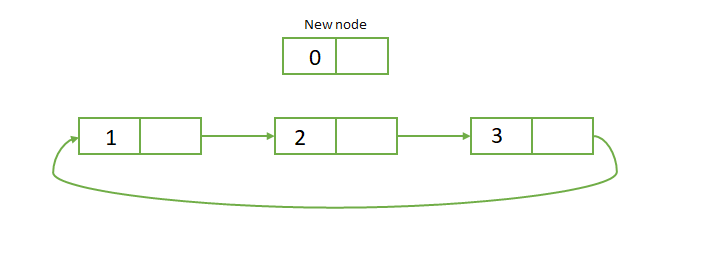Java程序在循环链表的开头插入一个新节点
循环链表:循环链表是一个元素序列,其中每个元素都指向序列中的下一个元素,最后一个元素与第一个元素相连。这意味着循环链表类似于单链表,除了最后一个节点指向列表中的第一个节点。
在循环链表的开头插入一个新节点:
如果链表为空,则 head 和 tail 都将指向新添加的节点。如果列表不为空,则将最后一个节点指向新添加的节点,将新添加的节点指向头节点,最后将新添加的节点作为头节点。


算法 :
- 创建一个代表列表中节点的 Node 类。它有两个变量 data 和 next 指针(指向下一个节点)。
- 创建另一个用于创建循环链表的类,它有两个节点,即头和尾。
- 当向列表中添加新节点时,我们将首先检查头部是否为空。如果列表为空或 head 为空,那么我们将插入节点作为头,尾也指向新添加的节点。
- 如果列表不为空,则新添加的节点将指向头部,尾部将指向新添加的节点,并将创建新节点作为头节点。
代码片段:
Java
// Java Program to Insert a nodes at the Beginning of the
// Circular Linked List
public class AddAtBeginning {
// Represents the node of list.
public class Node {
char data;
Node next;
public Node(char data) { this.data = data; }
}
// Declaring head and tail pointer as null.
// head indicates the starting node and tail indicates
// last node.
public Node head = null;
public Node tail = null;
// This function will add the new node at the Beginning
// of the circular linked list.
public void addNode(char data)
{
// Create new node
Node newNode = new Node(data);
// Checks if the list is empty.
if (head == null) {
// make newnode as both head and tail node.
head = newNode;
tail = newNode;
// point the tail to head node.
tail.next = head;
}
else {
// point the newnode to head
newNode.next = head;
// point the rail to new node.
tail.next = newNode;
// make the newnode as head.
head = newNode;
}
}
// printLinkedList prints all the nodes in the list
public void printLinkedList()
{
Node presentNode = head;
if (head == null) {
System.out.println("List is empty");
}
else {
System.out.println("\n");
// here with out checking anything we will print
// the first node, And print the rest of the
// nodes till the pointer again reaches the head
// node.
do {
System.out.print(" " + presentNode.data);
// incrementing the nodes using next
// property.
presentNode = presentNode.next;
// if present node is head, stop printing
// the nodes.
} while (presentNode != head);
}
}
public static void main(String[] args)
{
AddAtBeginning obj = new AddAtBeginning();
System.out.println(
"Adding nodes at the beginning of the list: ");
obj.addNode('s');
obj.printLinkedList();
// add k at the beginning
obj.addNode('k');
obj.printLinkedList();
// add e at the beginning
obj.addNode('e');
obj.printLinkedList();
// add e at the beginning
obj.addNode('e');
obj.printLinkedList();
// add G at the beginning
obj.addNode('G');
obj.printLinkedList();
}
}输出
Adding nodes at the beginning of the list:
s
k s
e k s
e e k s
G e e k s时间复杂度: O(1)